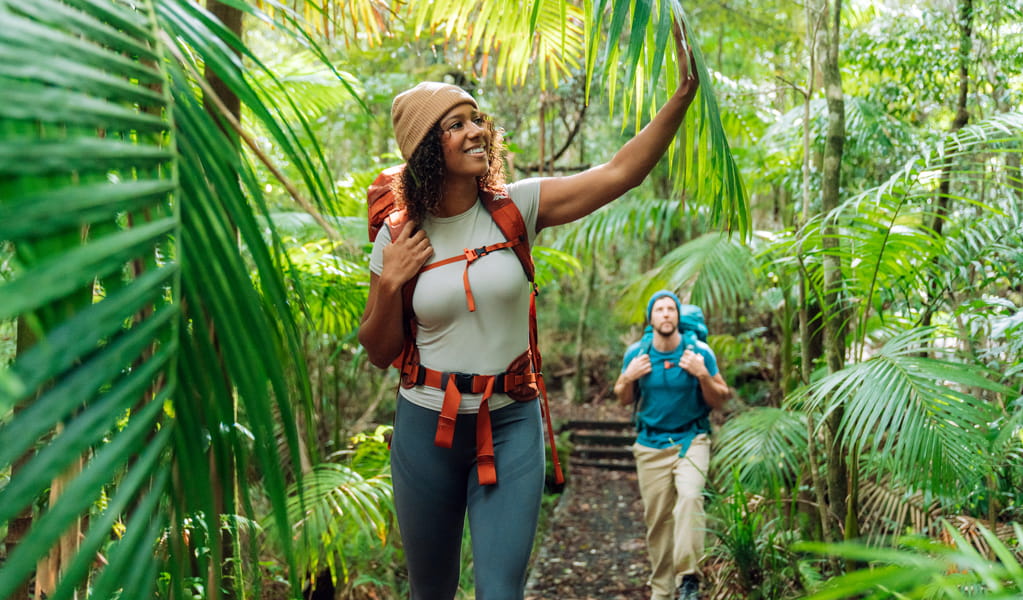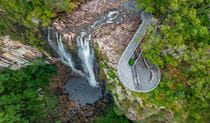Byan Yangala loop walk
North Coast
Overview
Travel back in time as you walk through ancient Gondwana rainforest on the Byan Yangala loop walk. Immerse yourself in nature less than 1 hour from Byron Bay.
- Accessibility
- No wheelchair access
- Distance
- 6.5km loop
- Time suggested
- 2 - 3hrs
- Grade
- Grade 3
- What to
bring - Binoculars, drinking water, hat, snacks, sturdy shoes, sunscreen, suitable clothing, raincoat
- Please note
- There are some steep sections along the track.
- There are several creek crossings on duck boards and stepping stones that can become slippery when wet.
- Be prepared to wade through shallow water during periods of high rainfall.
Byan Yangala (bee-yun yun-gulla) means ‘day walk’. This remote loop walk through wet and dry eucalypt forest and rainforest is a green cathedral for nature lovers, bushwalkers and campers staying nearby.
Start at Rummery Park campground where you can use the facilities before you set out. Then follow the loop clockwise to minimise meeting other walkers, and revel in the peace and birdsong.
Parts of this walk offer filtered glimpses of the distant coast and Snows Gully Nature Reserve through the forest. Be awe inspired by the tall trees towering over you and enjoy crossing the many creeks where Fleays barred and pouched frogs call. See if you can spot kookaburras or even koalas in the trees. Bring your binoculars to better see shy woodland birds including the rufous scrub bird and regent bowerbird.
If you’re keen to try more walks in the area, stroll along the rainforest-lined Boggy Creek, watch Minyon Falls plunging down to the rocks beneath, and bring a snack to reward yourself at the lookout’s picnic area.
Nearby
Map

Map legend

Local alerts
For the latest updates on fires, closures and other alerts in this area, see https://www.nationalparks.nsw.gov.au/things-to-do/walking-tracks/byan-yangala-loop-walk/local-alerts
General enquiries
- National Parks Contact Centre
- 7am to 7pm daily
- 1300 072 757 (13000 PARKS) for the cost of a local call within Australia excluding mobiles
- parks.info@environment.nsw.gov.au
Park info
- in Whian Whian State Conservation Area in the North Coast region
Whian Whian State Conservation Area is always open but may have to close at times due to poor weather.
- in Nightcap National Park in the North Coast region
Nightcap National Park is always open but may have to close at times due to poor weather, fire danger or management operations.
Visitor info
All the practical information you need to know about Byan Yangala loop walk.
Track grading
Features of this track
Distance
6.5km loop
Time
2 - 3hrs
Quality of markings
Clearly sign posted
Experience required
Some bushwalking experience recommended
Gradient
Short steep hills
Steps
Occasional steps
Quality of path
Formed track, some obstacles
Getting there and parking
Byan Yangala loop walk starts from Rummery Park campground in Whian Whian State Conservation Area.
From the eastern park entrance (via Rosebank):
- Take Minyon Drive past Minyon Falls picnic area, over the causeway.
- Continue along Minyon Drive until you reach the Peates Mountain Road intersection.
- Turn right onto Peates Mountain Road. Rummery Park campground is around 100m to the north.
From the southern park entrance (via Dunoon):
- Continue north up Nightcap Range Road to the top of the range.
- Turn left onto Peates Mountain Road. Rummery Park campground is around 100m to the north.
- The Peates Mountain link to Gibbergunyah Range Road is now closed and is gated at Rummery Park.
Road quality
Some roads in the park are narrow and winding.
- Mixture of sealed and unsealed roads
Vehicle access
- 2WD vehicles
Weather restrictions
- All weather
Parking
Parking is available at Rummery Park campground.
Facilities
The toilets, barbecues, picnic tables and carpark are located at Rummery Park campground which is where this walk starts.
Toilets
- Non-flush toilets
Picnic tables
Barbecue facilities
- Gas/electric barbecues (free)
Carpark
Maps and downloads
Accessibility
Disability access level - no wheelchair access
Prohibited
Camping
Cycling
There are other cycling options available from Rummery Park campground.
Gathering firewood
Horses
Smoking
NSW national parks are no smoking areas.
Learn more
Byan Yangala loop walk is in Whian Whian State Conservation Area. Here are just some of the reasons why this park is special:
4,000 years of Aboriginal culture

The conservation area is located within the traditional lands of the Widjabal clan of the Bundjalung Nation. Evidence from recorded sites suggests Aboriginal use of the Nightcap Range for at least the last 4,000 years. The area has intrinsic cultural values to the Widjabal People and the land has significant connections with other recorded sites in the adjacent Nightcap National Park.
- Byan Yangala loop walk Travel back in time as you walk through ancient Gondwana rainforest on the Byan Yangala loop walk. Immerse yourself in nature less than 1 hour from Byron Bay.
Historic heritage of timber-getters

Lured by the opportunity of employment in difficult times, timber-getters began logging in the Whian Whian area in the 1830s for red cedar, a particularly sought after timber. In 1871, surveyors identified a track over Nightcap Range to link Lismore with Murwillumbah. This allowed cedar-getters access to previously isolated expanses of forest. The Rummery Park campground was originally a forestry camp, and its use dates back to the 1930s. The inter-war period was the most active period for forestry use of the campground. Peates Mountain Road (now part of the Nightcap track) was built during the depression of the 1920s and 1930s. Sleeper-cutters who claimed timber unsuitable for milling, camped nearby on the other side of Boggy Creek at Rummery Park.
- Historic Nightcap walking track Historic Nightcap walking track leads through World Heritage-listed rainforest, offering scenic views across Nightcap National Park and Whian Whian State Conservation Area, near Byron Bay.
Plant life galore

An astounding 520 plant species have been recorded here – making it an incredibly diverse place when it comes to vegetation. There are 10 broad ecosystems, including subtropical and warm temperate rainforests and various types of wet sclerophyll forest.
- Boggy Creek walk Boggy Creek walk in Whian Whian State Conservation Area takes you through blackbutt forest and along the beautiful Boggy Creek to Minyon Falls. You can swim in the inviting pools along the creek.
- Historic Nightcap walking track Historic Nightcap walking track leads through World Heritage-listed rainforest, offering scenic views across Nightcap National Park and Whian Whian State Conservation Area, near Byron Bay.
Walk with the animals

There’s also an incredible variety of native animal species thriving in these rainforests – over 270 native species, around 50 of which are listed as threatened, including the spotted tailed quoll. Koalas and Albert’s lyrebird, with its distinctive calls and mimicking echoes, can often be heard through the forest in the cooler months.
- Byan Yangala loop walk Travel back in time as you walk through ancient Gondwana rainforest on the Byan Yangala loop walk. Immerse yourself in nature less than 1 hour from Byron Bay.
- Whian Whian mountain biking trails Suitable for bushwalkers, cyclists and horseriders, Whian Whian mountain biking trails near Byron Bay offer stunning views of waterfalls and rainforest.
World heritage worthy

The conservation area has similar vegetation and natural heritage values as those found in the adjoining Nightcap National Park, one of the 50 reserves in northeast NSW and southeast Queensland that make up World Heritage Central Eastern Rainforest Reserves Australia.
- Whian Whian mountain biking trails Suitable for bushwalkers, cyclists and horseriders, Whian Whian mountain biking trails near Byron Bay offer stunning views of waterfalls and rainforest.
Plants and animals protected in this park
Animals
-

Albert's lyrebird (Menura alberti)
The Albert’s lyrebird is much rarer than the superb lyrebird. Distinguished by its richer brown plumage and less elaborate tail feathers, it’s protected as a threatened species in NSW.
-

Koala (Phascolarctos cinereus)
One of the most renowned Australian animals, the tree-dwelling marsupial koala can be found in gum tree forests and woodlands across eastern NSW, Victoria and Queensland, as well as in isolated regions in South Australia. With a vice-like grip, this perhaps most iconic but endangered Australian animal lives in tall eucalypts within a home range of several hectares.
-

Common brushtail possum (Trichosurus vulpecula)
One of the most widespread of Australian tree-dwelling marsupials, the common brushtail possum is found across most of NSW in woodlands, rainforests and urban areas. With strong claws, a prehensile tail and opposable digits, these native Australian animals are well-adapted for life amongst the trees.
-

Kookaburra (Dacelo novaeguineae)
Of the 2 species of kookaburra found in Australia, the laughing kookaburra is the best-known and the largest of the native kingfishers. With its distinctive riotous call, the laughing kookaburra is commonly heard in open woodlands and forests throughout NSW national parks, making these ideal spots for bird watching.






